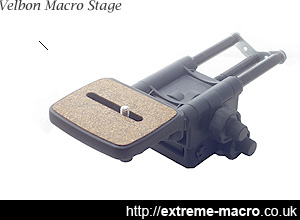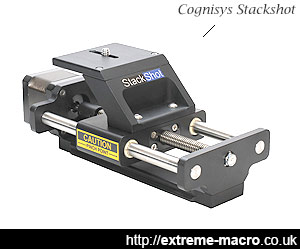Extreme Macro Stages
by Johan J Ingles-Le Nobel
Last updated August 31, 2017
No discussion of extreme macro is complete without some look at the stages we use. Stages are a fact of life in extreme macro, from crude positioning stages costing the price of a meal to a precision-made universal stacking stage, costing the same price as the family car. Various words are used to descibe the same thing: a macro stage, macro rail or macro slide all describes the same device; one used to move camera in small increments.
Positioning Stages
Pentax-M series bellows, an old 1970s piece of equipment that is beautifully crafted and still gives an excellent performance almost 50 years later. Great for first steps into extreme macro photography. Technically not a stage, but can be used as such.
It's a nice thing to have some cheap macro stages available which help the extreme macro photographer position the subject to be shot and the camera itself.
Bellows
It's a toss up whether bellows or a macro stage are the first thing that people buy when they get into macro, but a decent bellows set is a must. I have (probably wrongly) classified it as a stage for this website, as it can also be used for camera positioning. Interesting reading, you'd be surprised at the difference between rubbish and decent bellows. There are some superb third part bellows available as well, such as the Novoflex bellows system and the Actus mini, but these are out of pocket for hobbyist photographers.
Macro Rail
A Velbon macro stage, a handy piece of kit to have in the bag especially for outside work. Stages like this get a bad rap although they're more than capable of images in the 1:1 to 3:1 range.
A macro rail is usually a small 2 axis device that lets you move your camera about on a tripod. They're not very expensive and are usually a reasonable first step into extreme macro. I quite like the Velbon Stage I use, both in the field and in the studio.
Many cheap stages are available on eBay and whilst the workmanship might not be as well engineered as Velbon or Manfretto stages, the reports I've seen is that by and large they're perfectly ok for starting out stacking on a budget. Macro rail technology is constantly improving and there are now some interesting rails available from Hejnar with digital scales alongside, so you can measure your increments accurately.
Lab Lifter
If you're looking for something to move your specimen up and down in order to frame and compose the extreme macro image properly, you could do worse than get a cheap and cheerful lab lifter. You can even improve them a little bit too.
Other Stage Options
It wouldn't be fair to mention stacking stages without pointing people at some outstanding homemade devices made using Arduino and stepper motors. If you want to build your own you should go have a look through this most excellent article on how to build a focus stacking controller.
Microscope Stage
No, not the stage that controls a slide on a microscope, but a microscope-based x y z axis extreme macro stage that moves the whole specimen up, down, back, forward, and from side to side. It takes various bits and pieces to build one of these but it's very nice to have.
Universal Stage
Another homemade device, this time to control four degrees of rotation so that you can shoot your extreme macro image from any perspective. People also use goniometers for this, but beware that stacking goniometers on top of each other usually means that they do not have the same point of rotation. My own homemade universal stage does, is a very useful sub-$100 version of something that can cost many thousands.
Stackshot, the ultimate convenience in extreme macro stacking, capable of 1µm steps in its high precision mode. The bottom is a standard dovetail connection and the top is a standard tripod thread. Stackshot does everything you need for stacking and a little bit more and although it is an expensive initial purchase costing the same as a reasonable lens I still wouldn't want to be without it.
In terms of moving a specimen up and down, a nice cheap solution if you happen to have spare old lenses in boxes that you do not use is just to use one of these as a stage. By having a specimen on an endcap and adjusting focus, the lens makes for finely graduated movement up and down. Obviously you want a lens which doesn't rotate at the front.
Electronic Macro Rails
Electronic macro rails offer small repeatable incremental movements that are essential for deep stacks containing many images at extreme magnifications. These are electronic divices costing $100s, but also the highest precision and convenience devices available. The most developed is the Cognisys Stackshot, but there are now new options appearing on the market such as the WeMacro macro rail and various others. For those people who wish to make their own, fast stacker offers a complete plan for a "cheap, fast, portable, and accurate automated macro focus stacking rail (based on Arduino microcontroller) which can be used with a wide range of photo cameras, and magnifications from standard macro (1:1) to extreme macro (up to 20:1)."
The DIY Macro Stage, 2017
A very exciting option came out at the start of 2017, namely the DIY stacking kit. This gives the option to buy a kit and DIY it up into a fully-fledged, class-leading electronic macro focus-stacking rail, all at about half the total cost of the current class leader. The details of the DIY focus stacking kit are covered in my macro blog.
Manual Macro Rails
It is perfectly possible to use a Newport as a mechanical stacking stage as well and the majority of people start out this way. Newport stages are high quality devices typically sold by laboratory specialists, and they can also usually be found easily on eBay.
A Newport 423 single axis linear stage is a popular choice of stage for extreme macro, especially with a nice long-handled micrometer. An SM-25 micrometer has a primary scale graduated to 10µm (0.01mm) and a secondary scale graduated to 1µm (0.001mm). Proxxon rails are also a popular choice, and can move in increments of 10µm, and finer control can be achieved by mounting your own larger wheel with finer increments over the adjustment wheels.
Related Articles








